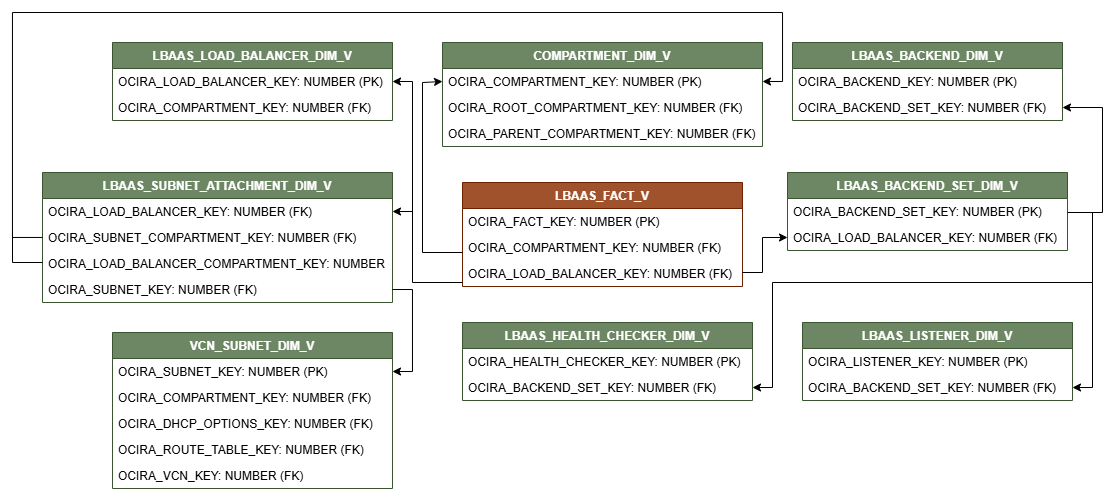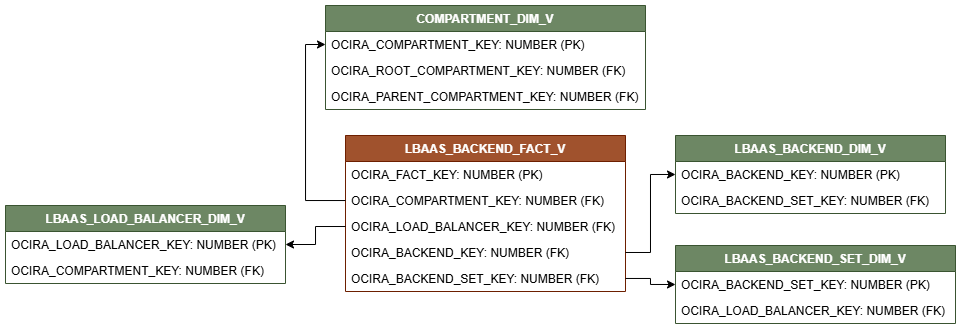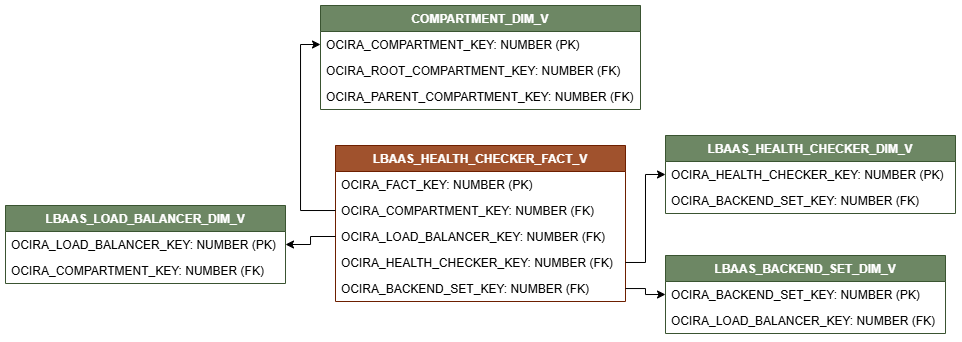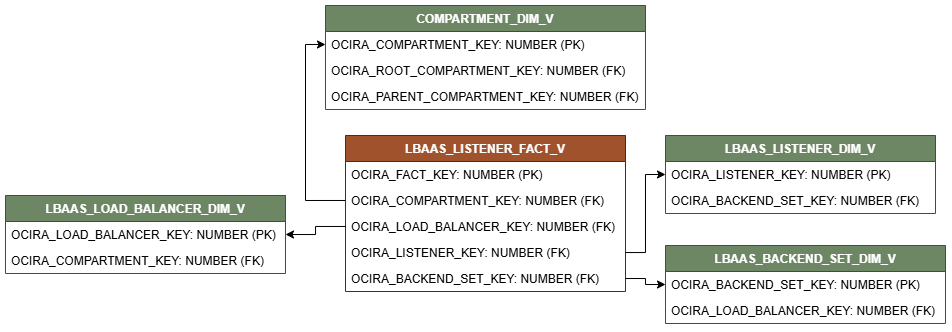Reference for Load Balancer
This guide lists the predefined objects inResource Analytics for Oracle Load Balancer. You can find information about views, entity relationships, subject areas and sample queries. The abbreviation LBaaS stands for Load Balancer as a Service.
Views
| View Name | Description |
|---|---|
| LBAAS_LOAD_BALANCER_DIM_V | This view stores information about the properties of a Load Balancer. |
| LBAAS_BACKEND_DIM_V | This view stores information about the configuration of a backend server in a Load Balancer backend set. |
| LBAAS_BACKEND_SET_DIM | This view stores information about the configuration of a Load Balancer backend set. |
| LBAAS_HEALTH_CHECKER_DIM_V | This view stores information about the configuration of the health check policy of a Load Balancer. |
| LBAAS_LISTENER_DIM_V | This view stores information about the configuration of a Load Balancer listener. |
| LBAAS_SUBNET_ATTACHMENT_DIM_V | This view stores information about the configuration of a subnet associated with a Load Balancer. |
| LBAAS_FACT_V | The fact for the Load Balancer service. Measures include backend set count, backend count, listener count, health checker count, public and private IP count. |
| LBAAS_RESOURCE_DETAILS_V | Denormalized view that show the backends, listeners, and health checkers associated with each Load Balancer and backend set combination. |
| LBAAS_BACKEND_FACT_V | Fact for Load Balancer backends. Measures include backend count. |
| LBAAS_HEALTH_CHECKER_FACT_V | Fact for Load Balancer health checkers. Measures include health checker count. |
| LBAAS_LISTENER_FACT_V | Fact for Load Balancer listeners. Measures include listener count. |
| LBAAS_SUBNET_FACT_V | Fact for Load Balancer subnets. Measures include subnet count. |
The suffixes in the view names specify the view type:
- FACT_V: Fact
- DIM_V: Dimension
- _V: Denormalized view
Relationship Diagram
This section provides diagrams that define the logical relationship of a fact table with different dimension tables.
The contents of each view and their relationships are listed in the following file: load balancer views.





Sample Queries
Sample queries for Load Balancer.
TIME_CREATED, COMPARTMENT_ID,
REGION, and LIFECYCLE_STATE
associated with all backend
sets:SELECT BS.BACKEND_SET_NAME, BS.LOAD_BALANCER_ID, L.TIME_CREATED, L.COMPARTMENT_ID, L.REGION, L.LIFECYCLE_STATE
FROM OCIRA.LBAAS_BACKEND_SET_DIM_V BS
INNER JOIN OCIRA.LBAAS_LOAD_BALANCER_DIM_V L
ON BS.OCIRA_LOAD_BALANCER_KEY = L.OCIRA_LOAD_BALANCER_KEY;TIME_CREATED, COMPARTMENT_ID,
REGION, and LIFECYCLE_STATE
associated with all
backends:SELECT B.BACKEND_NAME, L.ID, L.TIME_CREATED, L.COMPARTMENT_ID, L.REGION, L.LIFECYCLE_STATE
FROM OCIRA.LBAAS_BACKEND_DIM_V B
INNER JOIN OCIRA.LBAAS_BACKEND_SET_DIM_V BS
ON B.OCIRA_BACKEND_SET_KEY = BS.OCIRA_BACKEND_SET_KEY
INNER JOIN OCIRA.LBAAS_LOAD_BALANCER_DIM_V L
ON BS.OCIRA_LOAD_BALANCER_KEY = L.OCIRA_LOAD_BALANCER_KEY;TIME_CREATED, COMPARTMENT_ID,
REGION, and LIFECYCLE_STATE
associated with all health
checkers:SELECT H.HEALTH_CHECKER_NAME, L.ID, L.TIME_CREATED, L.COMPARTMENT_ID, L.REGION, L.LIFECYCLE_STATE
FROM OCIRA.LBAAS_HEALTH_CHECKER_DIM_V H
INNER JOIN OCIRA.LBAAS_BACKEND_SET_DIM_V BS
ON H.OCIRA_BACKEND_SET_KEY = BS.OCIRA_BACKEND_SET_KEY
INNER JOIN OCIRA.LBAAS_LOAD_BALANCER_DIM_V L
ON BS.OCIRA_LOAD_BALANCER_KEY = L.OCIRA_LOAD_BALANCER_KEY;TIME_CREATED, COMPARTMENT_ID,
REGION, and LIFECYCLE_STATE
associated with all
listeners:SELECT LS.LISTENER_NAME, L.ID, L.TIME_CREATED, L.COMPARTMENT_ID, L.REGION, L.LIFECYCLE_STATE
FROM OCIRA.LBAAS_LISTENER_DIM_V LS
INNER JOIN OCIRA.LBAAS_BACKEND_SET_DIM_V BS
ON LS.OCIRA_BACKEND_SET_KEY = BS.OCIRA_BACKEND_SET_KEY
INNER JOIN OCIRA.LBAAS_LOAD_BALANCER_DIM_V L
ON BS.OCIRA_LOAD_BALANCER_KEY = L.OCIRA_LOAD_BALANCER_KEY;SELECT F.LOAD_BALANCER_ID, D.DISPLAY_NAME
FROM OCIRA.LBAAS_FACT_V F
LEFT JOIN OCIRA.LBAAS_LOAD_BALANCER_DIM_V D
ON F.OCIRA_LOAD_BALANCER_KEY = D.OCIRA_LOAD_BALANCER_KEY
WHERE F.LIFECYCLE_STATE IN ('FAILED');SELECT F.LOAD_BALANCER_ID, BS.BACKEND_SET_NAME, B.BACKEND_NAME
FROM OCIRA.LBAAS_FACT_V F
LEFT JOIN OCIRA.LBAAS_BACKEND_SET_DIM_V BS
ON F.OCIRA_LOAD_BALANCER_KEY = BS.OCIRA_LOAD_BALANCER_KEY
LEFT JOIN OCIRA.LBAAS_BACKEND_DIM_V B
ON BS.OCIRA_BACKEND_SET_KEY = B.OCIRA_BACKEND_SET_KEY;SELECT F.LOAD_BALANCER_ID, BS.BACKEND_SET_NAME, L.LISTENER_NAME
FROM OCIRA.LBAAS_FACT_V F
LEFT JOIN OCIRA.LBAAS_BACKEND_SET_DIM_V BS
ON F.OCIRA_LOAD_BALANCER_KEY = BS.OCIRA_LOAD_BALANCER_KEY
LEFT JOIN OCIRA.LBAAS_LISTENER_DIM_V L
ON BS.OCIRA_BACKEND_SET_KEY = L.OCIRA_BACKEND_SET_KEY;SELECT F.LOAD_BALANCER_ID, BS.BACKEND_SET_NAME, L.LISTENER_NAME
FROM OCIRA.LBAAS_FACT_V F
LEFT JOIN OCIRA.LBAAS_BACKEND_SET_DIM_V BS
ON F.OCIRA_LOAD_BALANCER_KEY = BS.OCIRA_LOAD_BALANCER_KEY
LEFT JOIN OCIRA.LBAAS_LISTENER_DIM_V L
ON BS.OCIRA_BACKEND_SET_KEY = L.OCIRA_BACKEND_SET_KEY;SELECT F.LOAD_BALANCER_ID, SA.SUBNET_ID
FROM OCIRA.LBAAS_FACT_V F
JOIN OCIRA.LBAAS_SUBNET_ATTACHMENT_DIM_V SA
ON F.OCIRA_LOAD_BALANCER_KEY = SA.OCIRA_LOAD_BALANCER_KEY;SELECT F.LOAD_BALANCER_ID, T.TAG_TYPE, T.TAG_KEY_NAME, T.TAG_VALUE
FROM OCIRA.LBAAS_FACT_V F
LEFT JOIN OCIRA.TAGS_DIM_V T
ON F.LOAD_BALANCER_ID = T.RESOURCE_ID;Data Lineage
The Customer Experience Semantic Model Lineage spreadsheet and Metric Calculation Logic spreadsheet for Load Balancer provides an end-to-end data lineage summary report for physical and logical relationships in your data.
For more information, see Data Lineage.
Subject Areas
This section provides information on the subject areas with data you maintain in Load Balancer. These subject areas, with their corresponding data, are available for you to use when creating and editing analyses and reports. The information for each subject area includes:
-
Description of the subject area.
-
Business questions that can be answered by data in the subject area, with a link to more detailed information about each business question.
-
Job-specific groups and duty roles that can be used to secure access to the subject area, with a link to more detailed information about each job role and duty role.
-
Primary navigation to the work area that's represented by the subject area.
-
Time reporting considerations in using the subject area, such as whether the subject area reports historical data or only the current data. Historical reporting refers to reporting on historical transactional data in a subject area. With a few exceptions, all dimensional data are current as of the primary transaction dates or system date.
-
The lowest grain of transactional data in a subject area. The lowest transactional data grain decides how data are joined in a report.
-
Special considerations, tips, and things to look out for in using the subject area to create analyses and reports.